Study on Axial Compression Stability of Q345 Large-Section Angle Steel Columns
Abstract
:1. Introduction
2. Specimen Data and Test Method
2.1. Material Properties
2.2. Geometric Properties and Initial Imperfections
2.3. Rotation Stiffness of the End
2.4. Test Configuration
- (1)
- Centering: It includes rough centering and fine centering. Rough centering is to pre-mark the position of the centroid of the specimen on the bottom plate of the end and then coincide the centroid of the specimen with it. A fine centering is achieved by applying a load of no more than 100 kN to the specimen. Then, adjust the position of the specimen according to the measured strain data until the values of the six strain measurement points stay the same.
- (2)
- Step load testing: It includes three stages, as shown in Table 4.
- (3)
- Ultimate state and unloading: When the following situations occur during the test, it indicates that the specimen has reached the ultimate state: (1) The load no longer increases, but the displacement data is still changing continuously and the growth rate is relatively fast; (2) The strain data suddenly increases and may even exceed the range of measurement, resulting in overflow failure; and (3) The load can no longer increase and fall back. When the specimen reaches the ultimate state, the loading should be stopped immediately and unloaded slowly.
3. Test Results and Analysis
3.1. Buckling Modes
3.2. Buckling Capacity
- (1)
- The initial imperfections of the specimens were quite small, lower than the 1/1000L adopted in the specification.
- (2)
- In some specifications, it is considered that the buckling mode of the short column is flexural–torsional buckling, which is inconsistent with the test results, resulting in a low buckling factor in the specification.
- (3)
- Compared with Q235 steel, Q345 steel has a shorter yield plateau. However, in the current specifications, the constitutive model of Q345 steel adopts the perfect elastic–plastic model, which underestimates the buckling capacity of the specimens.
- (4)
- It can be seen from Figure 7 that the horizontal deformation of the short specimens was not noticeable before buckling, and the yield plateau of Q345 steel is shorter than that of Q235 steel. It made Q345 LAS columns soon come into strain-hardening progress without significant plastic deformations as Q235 steel columns. This is an inelastic stage buckling, and the sectional stress σ may be greater than the yield strength fy, resulting in the buckling factor exceeding 1.0.
4. Finite Element Model and Validation
4.1. Finite Element Model
4.2. Model Validation
5. Discussion and Design Approach
5.1. Discussion
- (1)
- Previous research has always selected flexural–torsional buckling as the buckling mode of short LAS columns to simulate and analyze. However, it can be seen from the test results that normal-strength LAS columns failed in the flexural buckling. The width–thickness ratio of LAS columns is small, so their local stability is good and local buckling does not occur. Therefore, this paper used flexural buckling as the buckling mode of short LAS columns, which increased the buckling factor, which is consistent with the test results.
- (2)
- The perfect elastic–plastic model is used for the stress–strain relationship of normal-strength LAS columns in specifications, ignoring the influence of strain-stiffening. However, when the stress of the short column is close to the yield strength, its displacement still develops little so that it will not immediately buckle when the stress on the section of the column exceeds the yield strength, resulting in a higher buckling capacity. In this paper, the five-stage constitutive model was used in the FE model, which fully considers the influence of strain stiffening, so the calculation results were higher than the specifications.
- (3)
- With the increase in steel strength, the yield plateau of ordinary low-alloy structural steel is also gradually shortened. Although its reduction is not as large as that of high-strength steel, it is still a positive factor for columns to enter the strain-hardening process as soon as possible. The influence of strain hardening on the buckling capacity cannot be ignored.
5.2. Design Approach
6. Conclusions
- (1)
- The slenderness of the specimens under axial compression can be corrected by measuring the rotational stiffness of the ends, and a more accurate buckling capacity can be obtained. The buckling mode of Q345 LAS columns was flexural buckling. Local buckling does not occur due to the small width–thickness ratio. Initial imperfections in specimens were the main reason for the flexural–torsional buckling of short specimens.
- (2)
- The tested buckling capacity of Q345 LAS columns was significantly higher than the corresponding calculated value in the current design specifications. The current specifications were conservative in calculating such components, especially for predicting the components with small slenderness.
- (3)
- A FE model of the Q345 LAS column was established based on the measured geometric properties and initial imperfections. The results of the test verified that the FE model was accurate enough.
- (4)
- The material strength, constitutive model, and buckling mode were the main factors that affected the buckling capacity of Q345 LAS columns. The change in cross-section size has little effect on the buckling capacity of Q345 LAS columns, which can be ignored.
- (5)
- The FE buckling factors of Q345 LAS columns were higher than the predicted values in the current specification. The curve a in GB50017-2017 was the closest, followed by the curve a in Eurocode 3. While the prediction values of ASCE 10-15 and AISC 360-16 were not accurate enough.
- (6)
- A new column curve was proposed and proved accurate enough for Q345 LAS columns under axial compression. This new curve thoroughly considered the excellent bearing capacity of short columns. The curve can be expressed as follows: when λn ≤ 0.419, φ = 1.0. When λn > 0.419, the curve can be expressed by Equation (14).
Author Contributions
Funding
Data Availability Statement
Acknowledgments
Conflicts of Interest
References
- Shi, G.; Liu, Z.; Ban, H.Y.; Shi, Y.J.; Wang, Y.Q. Tests and finite element analysis on the local buckling of 420MPa steel equal angle columns under axial compression. Steel Compos. Struct. 2012, 12, 31–51. [Google Scholar] [CrossRef]
- Ban, H.Y.; Shi, G.; Shi, Y.J.; Wang, Y.Q. Overall buckling behavior of 460 MPa high strength steel columns: Experimental investigation and design method. J. Constr. Steel Res. 2012, 74, 140–150. [Google Scholar] [CrossRef]
- Sun, Y.; Guo, Y.J.; Chen, H.Y.; Cao, K. Stability of large-size and high-strength steel angle sections affected by support constraint. Int. J. Steel Struct. 2021, 21, 85–99. [Google Scholar] [CrossRef]
- Ye, J.; Rasmussen, K.J. Compression strength of unstiffened elements in cold-reduced high strength steel. J. Struct. Eng. 2008, 134, 189–197. [Google Scholar] [CrossRef]
- Cao, K.; Guo, Y.J.; Zeng, D.W. Buckling behavior of large-section and 420 MPa high-strength angle steel columns. J. Constr. Steel Res. 2015, 111, 11–20. [Google Scholar] [CrossRef]
- Shi, G.; Chen, X.S. Research advances in HSS structures at Tsinghua University and codification of the design specification. Steel Constr.-Des. Res. 2018, 11, 286–293. [Google Scholar] [CrossRef]
- Bijlaard, F.; Veljkovic, M.; Shi, G.; Qiang, X.H. Implementation of high-strength, high-performance steel structures. Steel Constr.-Des. Res. 2018, 11, 247–248. [Google Scholar] [CrossRef]
- BS EN 1993-1-1; Eurocode3: Design of Steel Structures: Part 1-1: General Rules and Rules for Buildings. BSI: London, UK, 2005.
- GB50017-2003; Code for Design of Steel Structures. China Architecture & Building Press: Beijing, China, 2003. (In Chinese)
- ASCE 10-2015; Design of Latticed Steel Transmission Structures. ASCE: Washington, DC, USA, 2015.
- ANSI/AISC 360-2016; Specification for Structural Steel Buildings. AISC: Chicago, IL, USA, 2016.
- GB50017-2017; Standard for Design of Steel Structures. China Architecture & Building Press: Beijing, China, 2017. (In Chinese)
- Moze, P.; Cajot, L.G.; Sinur, F. Residual stress distribution of large steel equal leg angles. Eng. Struct. 2014, 71, 35–47. [Google Scholar] [CrossRef]
- Ban, H.Y.; Shi, G.; Shi, Y.J.; Wang, Y.Q. Column buckling tests of 420 MPa high strength steel single equal angles. Int. J. Struct. Stab. Dyn. 2013, 13, 1250069-1–1250069-23. [Google Scholar] [CrossRef]
- Ban, H.Y.; Shi, G.; Shi, Y.J. Residual stress tests of high-strength steel equal angles. J. Struct. Eng. 2012, 138, 1446–1454. [Google Scholar] [CrossRef]
- Shi, G.; Zhang, Z.Q.; Zhou, L.; Gao, Y. Experimental study and modeling of residual stresses of Q420 large-section angles. J. Constr. Steel Res. 2020, 167, 105958. [Google Scholar] [CrossRef]
- Chen, S.F. Elastic and inelastic stability capacity of single angle under axial compression. J. Build. Struct. 2012, 33, 134–141. (In Chinese) [Google Scholar]
- Shi, G.; Zhou, W.J.; Bai, Y.; Lin, C.C. Local buckling of steel equal angle members with normal and high strengths. Int. J. Steel Struct. 2014, 14, 447–455. [Google Scholar] [CrossRef]
- Qu, S.Z.; Wang, J.Y.; Guo, Y.H.; Hao, J.P.; Yang, X.C. Experiment and code-based study on high-strength steel pin-ended angles under axial compression. Thin-Walled Struct. 2020, 149, 106541-1–106541-22. [Google Scholar] [CrossRef]
- Cao, K.; Guo, Y.J.; Xu, J. Buckling analysis of columns ended by rotation-stiffness spring hinges. Int. J. Steel Struct. 2016, 16, 1–9. [Google Scholar] [CrossRef]
- Liu, H.Y.; Li, Z.L.; Huang, Z.L. A study on the bearing capacity of angle steel members in transmission towers. Prog. Steel Build. Struct. 2021, 23, 47–55. (In Chinese) [Google Scholar]
- BS EN 10002-1; Metallic Materials Tensile Testing, Part 1: Method of Test at Ambient Temperature. BSI: London, UK, 2001.
- Huang, X.; Yuan, Y.; Zhao, J.; Wei, C.C. Comparative study on ultra-low-cycle-fatigue behavior of Q235 normal-steel and Q690 high-strength steel. J. Constr. Steel Res. 2022, 194, 107308. [Google Scholar] [CrossRef]
- Ban, H.Y.; Shi, G.; Shi, Y.J.; Mark, A.B. Experimental investigation of the overall buckling behaviour of 960 MPa high strength steel columns. J. Constr. Steel Res. 2013, 88, 256–266. [Google Scholar] [CrossRef]
- Zhang, L.L.; Wang, F.Y.; Liang, Y.T.; Zhao, O. Press-braked S690 high strength steel equal-leg angle and plain channel section stub columns: Testing, numerical simulation and design. Eng. Struct. 2019, 201, 109764. [Google Scholar] [CrossRef]
- Wang, Y.Z.; Kanvinde, A.; Li, G.Q.; Wang, Y.B. A new constitutive model for high strength structural steels. J. Constr. Steel Res. 2021, 182, 106646. [Google Scholar] [CrossRef]
- Kim, J.H.; Kim, D.; Han, H.N.; Barlat, F.; Lee, M.G. Strain rate dependent tensile behavior of advanced high strength steels: Experiment and constitutive modeling. Mater. Sci. Eng. A 2013, 559, 222–231. [Google Scholar] [CrossRef]
- Yun, X.; Gardner, L.; Boissonnade, N. The continuous strength method for the design of hot-rolled steel cross-sections. Eng. Struct. 2018, 157, 179–191. [Google Scholar] [CrossRef]
- Yang, X.; Yang, H.; Gardner, L.; Wang, Y. A continuous dynamic constitutive model for normal- and high-strength structural steels. J. Constr. Steel Res. 2022, 192, 107254. [Google Scholar] [CrossRef]



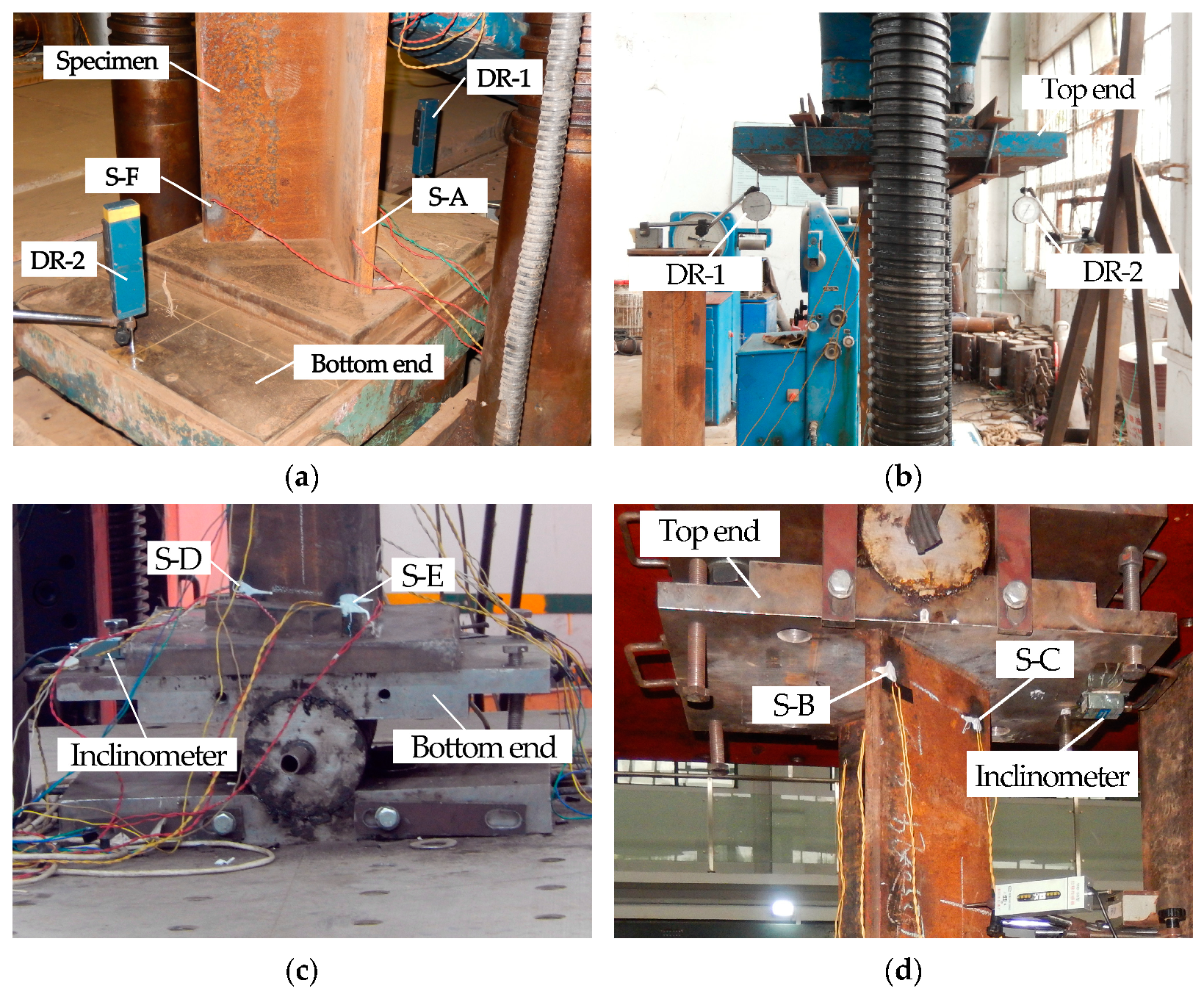


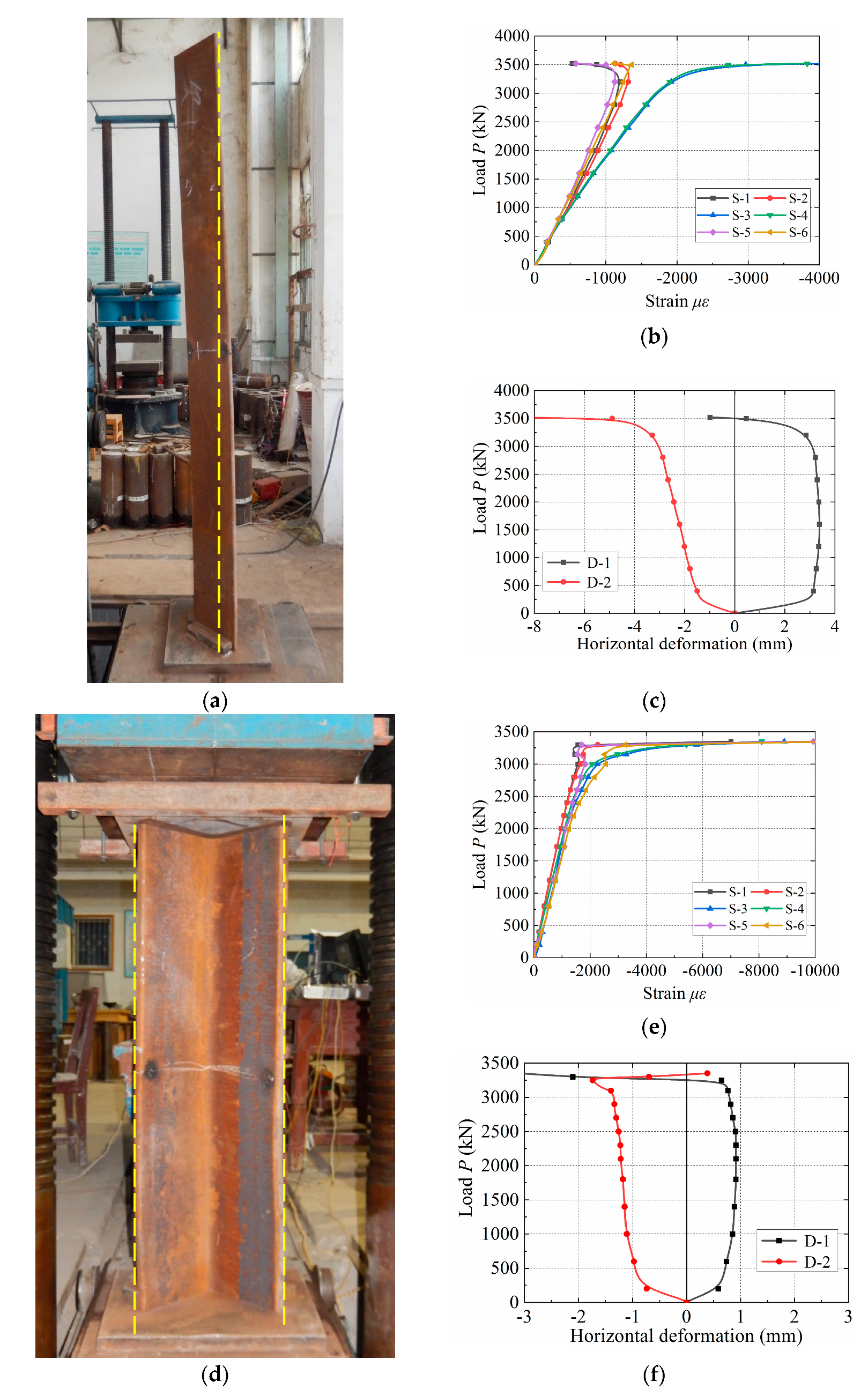
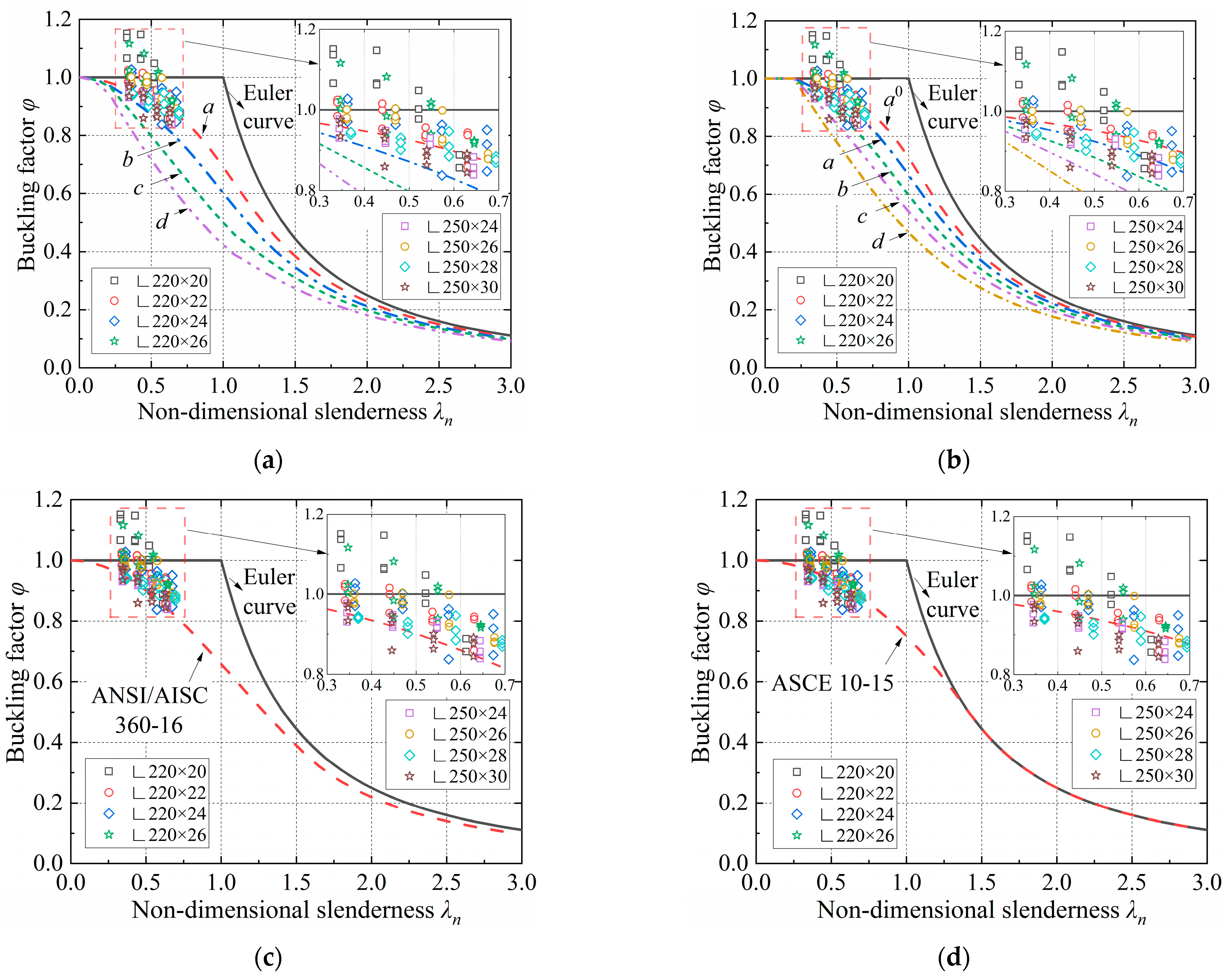
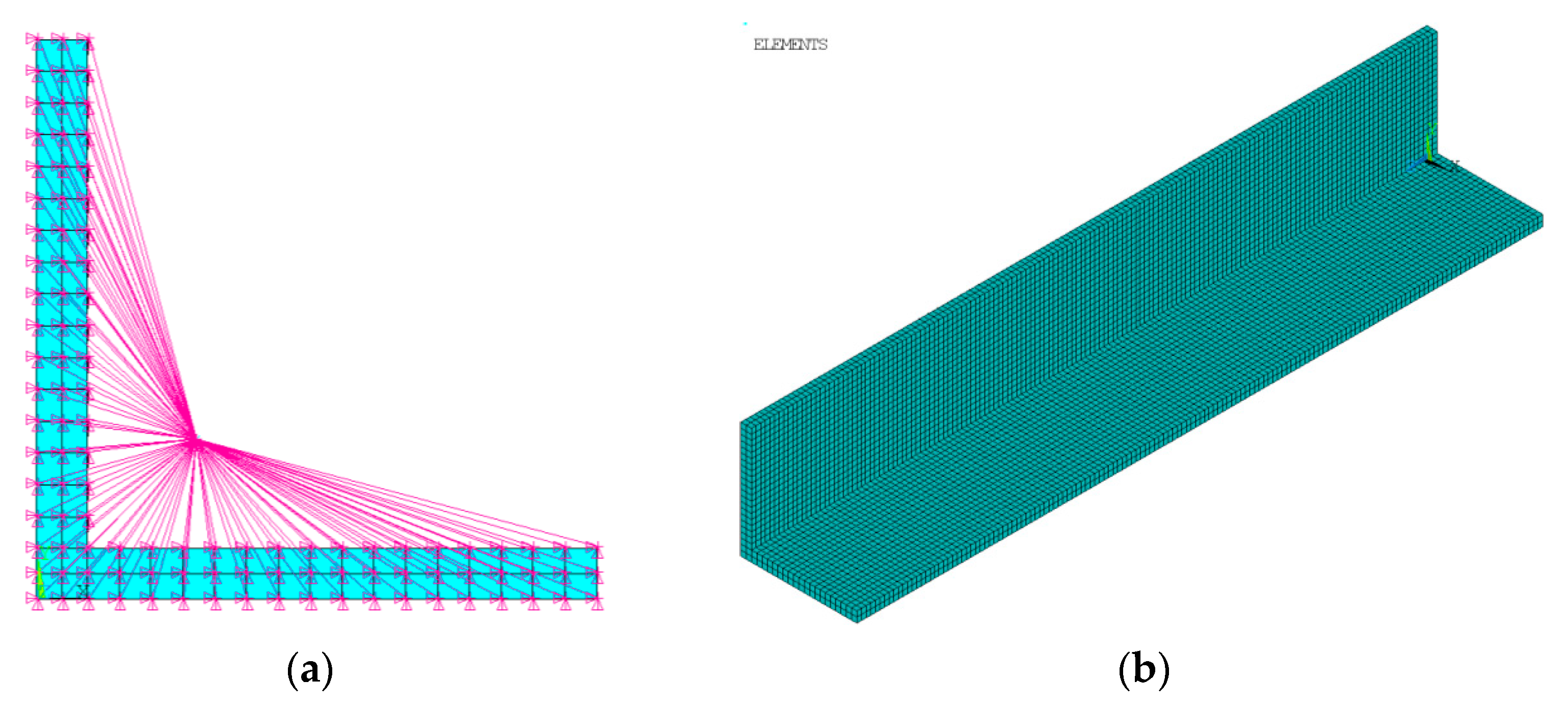



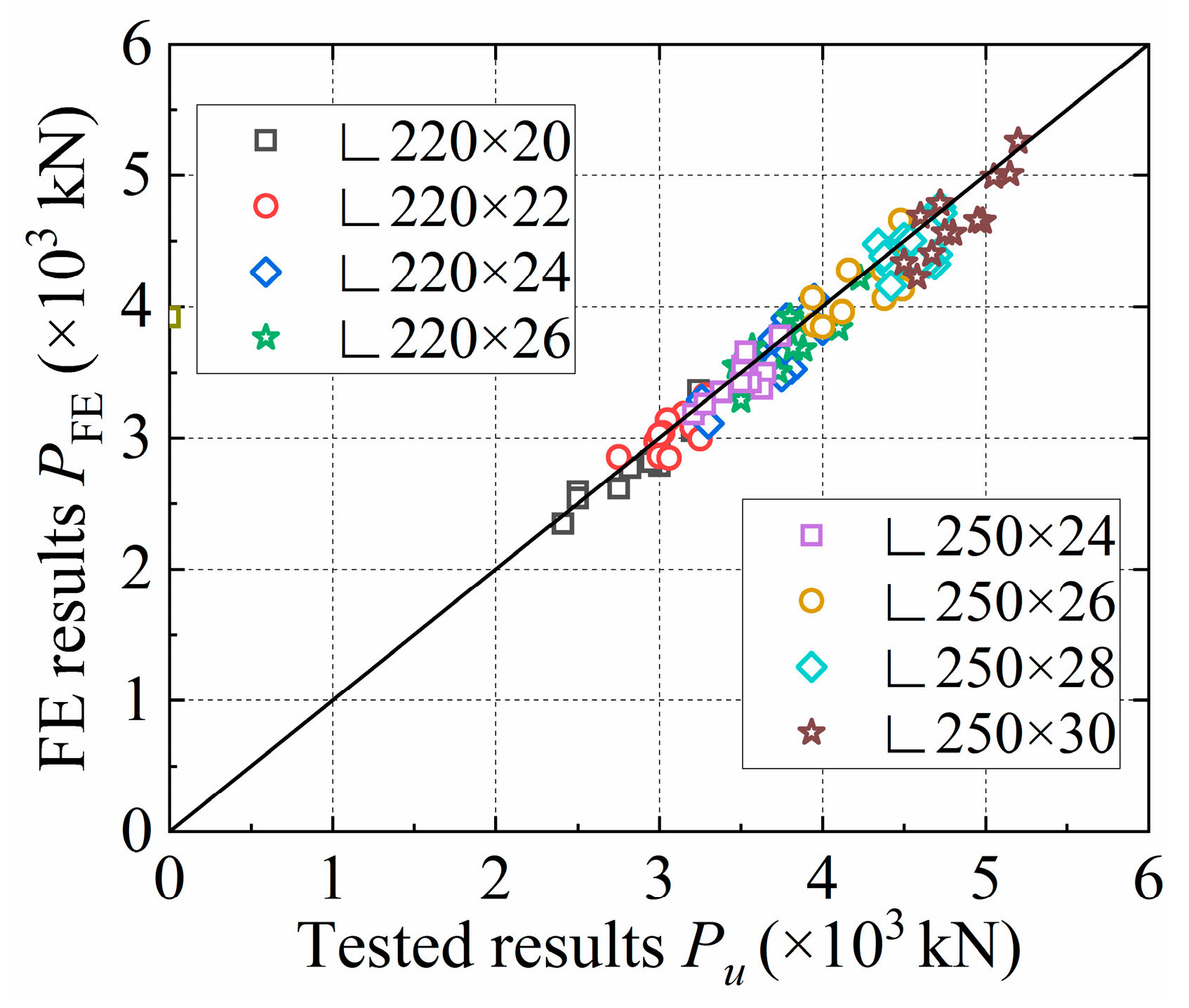
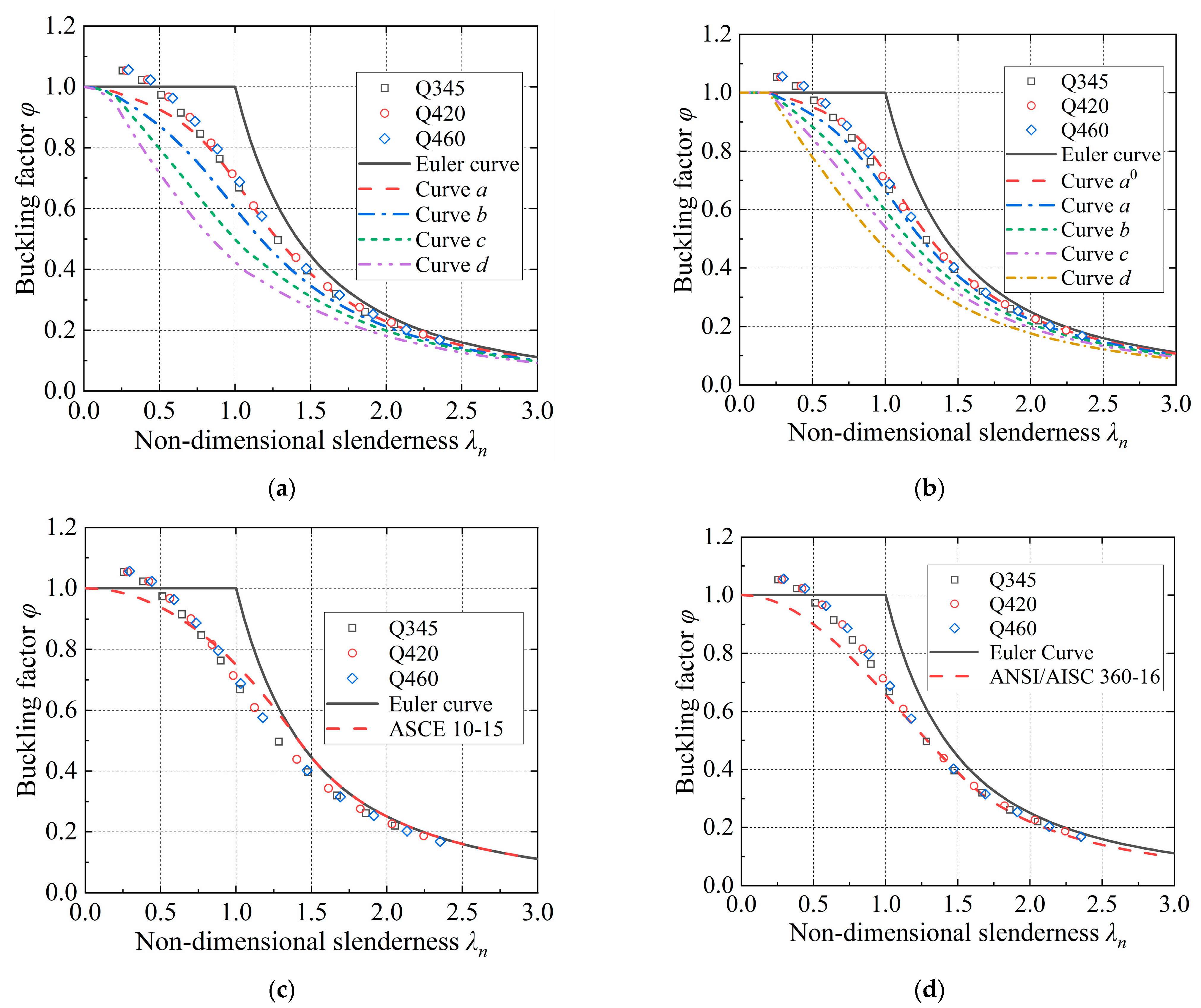
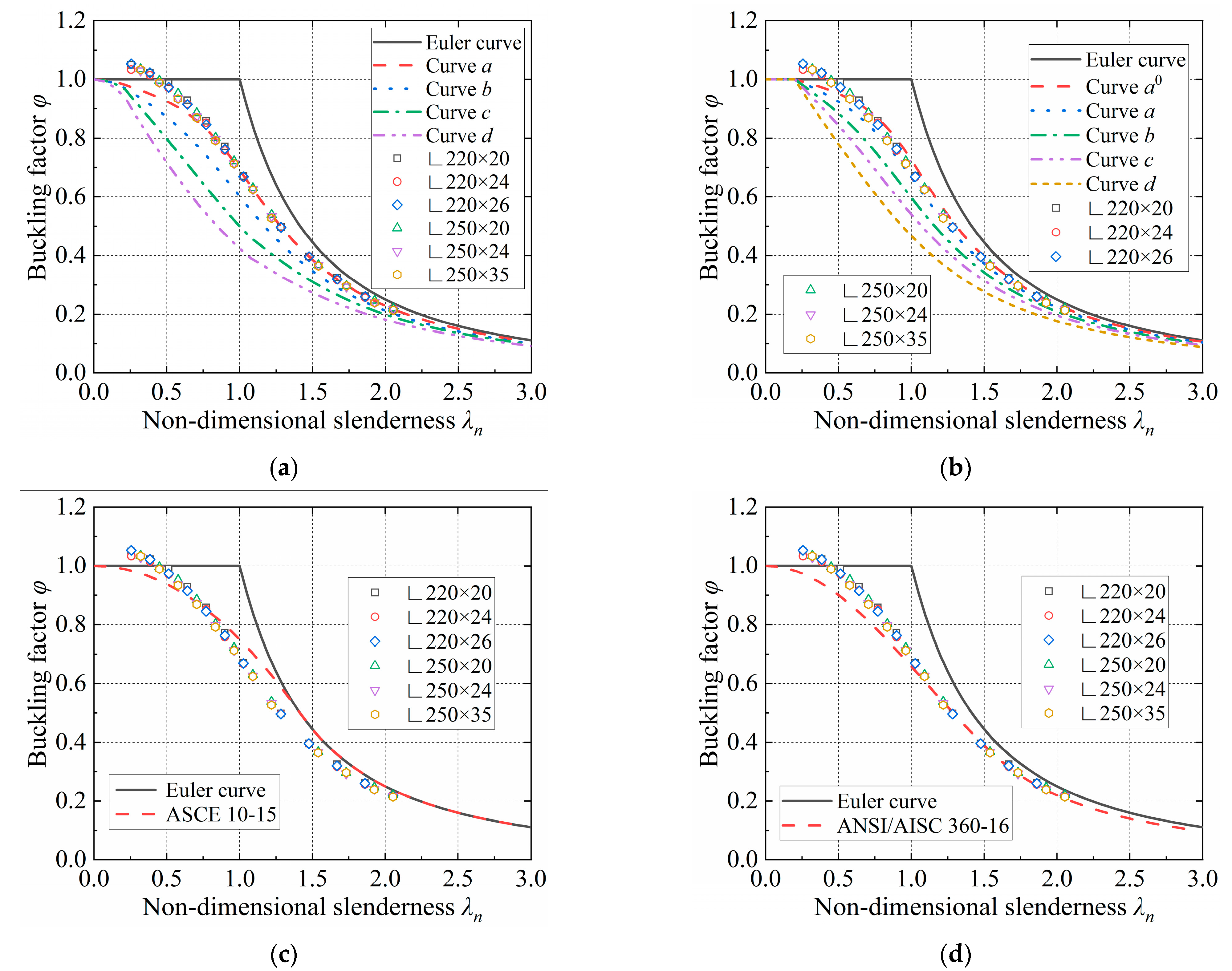
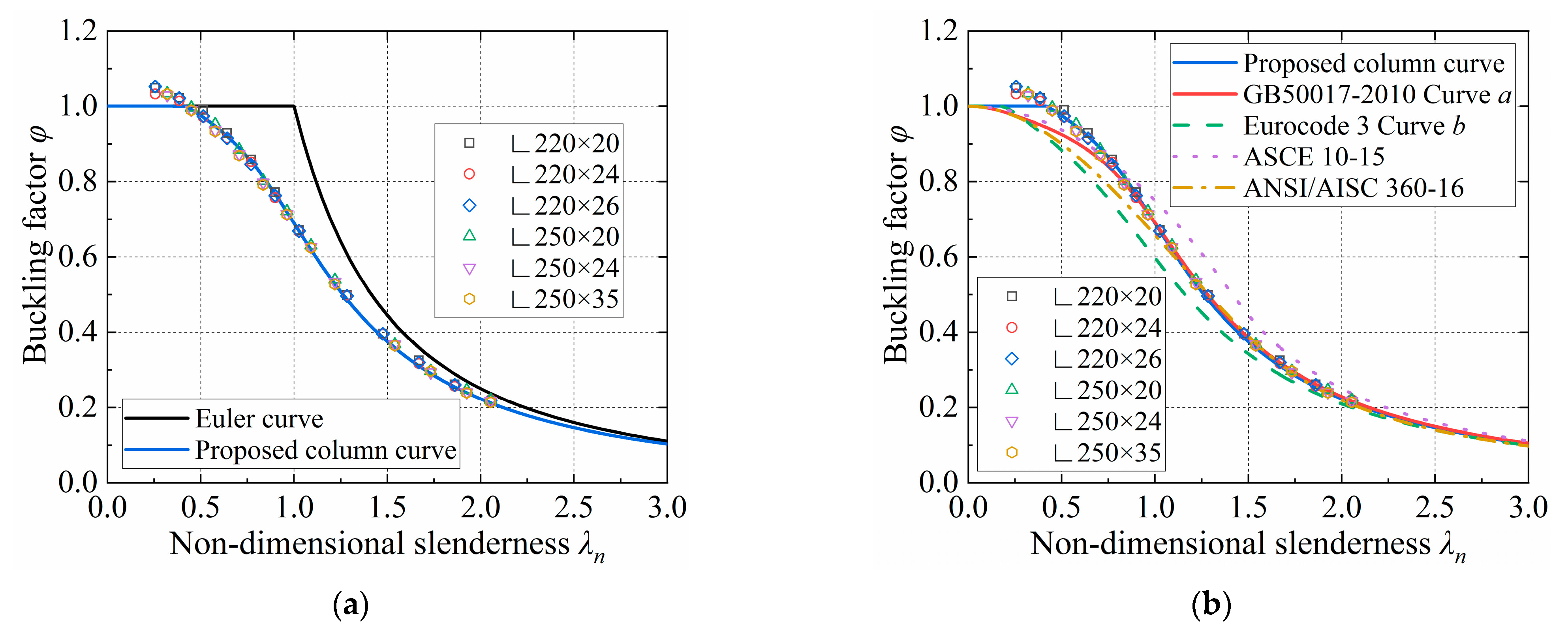
| Tension Coupon Label | Elastic Modulus E (MPa) | Yield Strength fy (MPa) | Ultimate Tensile Stress fu (MPa) | fu/fy |
|---|---|---|---|---|
| ∟220 × 20 | 2.05 × 105 | 335 | 509 | 1.52 |
| ∟220 × 22 | 2.06 × 105 | 348 | 519 | 1.49 |
| ∟220 × 24 | 2.08 × 105 | 390 | 550 | 1.41 |
| ∟220 × 26 | 2.03 × 105 | 352 | 518 | 1.47 |
| ∟250 × 24 | 2.06 × 105 | 335 | 505 | 1.51 |
| ∟250 × 26 | 2.13 × 105 | 364 | 565 | 1.55 |
| ∟250 × 28 | 2.10 × 105 | 378 | 554 | 1.47 |
| ∟250 × 30 | 2.11 × 105 | 378 | 543 | 1.44 |
| Specimen Label | Measured Geometric Properties (mm) | Initial Imperfections | |||
|---|---|---|---|---|---|
| b0 | t0 | l0 | η (‰) | θ (rad) | |
| ∟220 × 20-30 1 | 221.5 | 20.74 | 1031.6 | 0.76 | 0.003 |
| ∟220 × 20-40 | 220.7 | 20.35 | 1466.0 | 0.51 | 0.002 |
| ∟220 × 20-50 | 221.6 | 20.48 | 1898.4 | 0.42 | 0.003 |
| ∟220 × 20-60 | 221.7 | 20.37 | 2333.8 | 0.39 | 0.003 |
| ∟220 × 22-30 | 220.6 | 22.56 | 1024.9 | 0.74 | 0.001 |
| ∟220 × 22-40 | 222.7 | 22.54 | 1456.9 | 0.77 | 0.004 |
| ∟220 × 22-50 | 221.2 | 22.69 | 1889.1 | 0.62 | 0.002 |
| ∟220 × 22-60 | 222.0 | 22.67 | 2321.5 | 0.34 | 0.001 |
| ∟220 × 24-30 | 221.1 | 24.40 | 1022.2 | 0.69 | 0.000 |
| ∟220 × 24-40 | 221.2 | 24.55 | 1453.1 | 0.51 | 0.006 |
| ∟220 × 24-50 | 221.7 | 24.67 | 1884.6 | 0.57 | 0.002 |
| ∟220 × 24-60 | 221.2 | 24.43 | 2314.7 | 0.31 | 0.008 |
| ∟220 × 26-30 | 221.8 | 26.32 | 1019.5 | 0.52 | 0.007 |
| ∟220 × 26-40 | 221.5 | 26.58 | 1449.4 | 0.73 | 0.000 |
| ∟220 × 26-50 | 221.6 | 26.91 | 1879.5 | 0.58 | 0.001 |
| ∟220 × 26-60 | 221.2 | 26.46 | 2309.0 | 0.44 | 0.000 |
| ∟250 × 24-30 | 251.3 | 24.70 | 1204.7 | 0.68 | 0.004 |
| ∟250 × 24-40 | 252.3 | 24.61 | 1697.2 | 0.44 | 0.000 |
| ∟250 × 24-50 | 251.4 | 24.80 | 2188.4 | 0.62 | 0.005 |
| ∟250 × 24-60 | 250.8 | 24.76 | 2680.1 | 0.28 | 0.000 |
| ∟250 × 26-30 | 251.2 | 26.79 | 1199.7 | 0.37 | 0.004 |
| ∟250 × 26-40 | 252.7 | 26.58 | 1688.4 | 0.23 | 0.004 |
| ∟250 × 26-50 | 252.0 | 26.19 | 2179.8 | 0.46 | 0.003 |
| ∟250 × 26-60 | 251.9 | 26.50 | 2669.2 | 0.33 | 0.002 |
| ∟250 × 28-30 | 251.5 | 28.55 | 1195.9 | 0.59 | 0.003 |
| ∟250 × 28-40 | 251.9 | 28.42 | 1684.5 | 0.80 | 0.004 |
| ∟250 × 28-50 | 252.2 | 28.38 | 2173.6 | 0.45 | 0.002 |
| ∟250 × 28-60 | 252.0 | 28.56 | 2663.4 | 0.35 | 0.003 |
| ∟250 × 30-30 | 251.4 | 30.44 | 1210.0 | 0.53 | 0.002 |
| ∟250 × 30-40 | 251.9 | 30.59 | 1698.0 | 0.52 | 0.003 |
| ∟250 × 30-50 | 251.8 | 30.69 | 2185.9 | 0.46 | −0.001 |
| ∟250 × 30-60 | 251.3 | 30.78 | 2673.4 | 0.25 | −0.002 |
| ηmax and θmax | 0.80 | 0.008 | |||
| Tension Coupon Label | λ0 | |||
|---|---|---|---|---|
| λ = 30 | λ = 40 | λ = 50 | λ = 60 | |
| ∟220 × 20 | 25.76 | 33.31 | 40.60 | 47.68 |
| ∟220 × 22 | 25.98 | 33.64 | 41.02 | 48.19 |
| ∟220 × 24 | 26.18 | 33.92 | 41.39 | 48.64 |
| ∟220 × 26 | 26.36 | 34.17 | 41.71 | 49.04 |
| ∟250 × 24 | 26.82 | 34.85 | 42.60 | 50.14 |
| ∟250 × 26 | 26.97 | 35.08 | 42.91 | 50.52 |
| ∟250 × 28 | 27.12 | 35.29 | 43.20 | 50.88 |
| ∟250 × 30 | 25.44 | 32.67 | 39.54 | 46.13 |
| Load (kN) | Loading Speed (kN/s) | Increment (kN) |
|---|---|---|
| 0~1500 | 4 | 200 |
| 1500~0.8 Pu 1 | 2 | 100 |
| >0.8 Pu | 1 | 50 |
| Specimen Label | λn | Buckling Mode | Pu (kN) | φt | φF | φF/φt | Specimen Label | λn | Buckling Mode | Pu (kN) | φt | φF | φF/φt |
|---|---|---|---|---|---|---|---|---|---|---|---|---|---|
| ∟220 × 20-30-1 | 0.331 | F 1 | 3240 | 1.151 | 1.195 | 1.038 | ∟250 × 24-30-1 | 0.344 | F | 3560 | 0.930 | 0.913 | 0.982 |
| ∟220 × 20-30-2 | FT | 3200 | 1.137 | 1.085 | 0.954 | ∟250 × 24-30-2 | F | 3740 | 0.977 | 0.987 | 1.010 | ||
| ∟220 × 20-30-3 | FT | 3000 | 1.066 | 0.991 | 0.930 | ∟250 × 24-30-3 | FT | 3650 | 0.954 | 0.913 | 0.957 | ||
| ∟220 × 20-40-1 | 0.428 | F | 3000 | 1.066 | 1.020 | 0.957 | ∟250 × 24-40-1 | 0.447 | F | 3630 | 0.949 | 0.881 | 0.929 |
| ∟220 × 20-40-2 | F | 3230 | 1.148 | 1.107 | 0.964 | ∟250 × 24-40-2 | F | 3510 | 0.917 | 0.927 | 1.011 | ||
| ∟220 × 20-40-3 | F | 2990 | 1.063 | 1.019 | 0.959 | ∟250 × 24-40-3 | F | 3530 | 0.922 | 0.955 | 1.035 | ||
| ∟220 × 20-50-1 | 0.521 | F | 2750 | 0.977 | 0.929 | 0.951 | ∟250 × 24-50-1 | 0.547 | F | 3510 | 0.917 | 0.917 | 1.000 |
| ∟220 × 20-50-2 | F | 2950 | 1.048 | 1.002 | 0.955 | ∟250 × 24-50-2 | F | 3560 | 0.930 | 0.894 | 0.961 | ||
| ∟220 × 20-50-3 | F | 2820 | 1.002 | 0.986 | 0.984 | ∟250 × 24-50-3 | F | 3500 | 0.915 | 0.894 | 0.977 | ||
| ∟220 × 20-60-1 | 0.612 | F | 2410 | 0.856 | 0.833 | 0.973 | ∟250 × 24-60-1 | 0.644 | F | 3380 | 0.883 | 0.874 | 0.990 |
| ∟220 × 20-60-2 | F | 2500 | 0.888 | 0.921 | 1.037 | ∟250 × 24-60-2 | F | 3210 | 0.839 | 0.831 | 0.991 | ||
| ∟220 × 20-60-3 | F | 2500 | 0.888 | 0.902 | 1.015 | ∟250 × 24-60-3 | F | 3280 | 0.857 | 0.851 | 0.993 | ||
| ∟220 × 22-30-1 | 0.340 | FT | 3280 | 1.025 | 1.038 | 1.013 | ∟250 × 26-30-1 | 0.361 | F | 4380 | 0.976 | 0.906 | 0.928 |
| ∟220 × 22-30-2 | FT | 3260 | 1.019 | 1.015 | 0.996 | ∟250 × 26-30-2 | F | 4400 | 0.981 | 0.990 | 1.009 | ||
| ∟220 × 22-30-3 | F | 3150 | 0.984 | 0.994 | 1.010 | ∟250 × 26-30-3 | FT | 4490 | 1.001 | 0.922 | 0.921 | ||
| ∟220 × 22-40-1 | 0.440 | F | 3200 | 1.000 | 0.963 | 0.963 | ∟250 × 26-40-1 | 0.469 | F | 4500 | 1.003 | 0.959 | 0.956 |
| ∟220 × 22-40-2 | F | 3050 | 0.953 | 0.979 | 1.028 | ∟250 × 26-40-2 | F | 4370 | 0.974 | 0.953 | 0.979 | ||
| ∟220 × 22-40-3 | F | 3250 | 1.016 | 0.935 | 0.921 | ∟250 × 26-40-3 | F | 4410 | 0.983 | 0.961 | 0.978 | ||
| ∟220 × 22-50-1 | 0.537 | F | 2980 | 0.931 | 0.929 | 0.998 | ∟250 × 26-50-1 | 0.574 | F | 4480 | 0.999 | 1.038 | 1.039 |
| ∟220 × 22-50-2 | F | 3000 | 0.937 | 0.894 | 0.954 | ∟250 × 26-50-2 | F | 4120 | 0.918 | 0.883 | 0.961 | ||
| ∟220 × 22-50-3 | F | 3060 | 0.956 | 0.890 | 0.931 | ∟250 × 26-50-3 | F | 4160 | 0.927 | 0.954 | 1.028 | ||
| ∟220 × 22-60-1 | 0.630 | F | 2750 | 0.859 | 0.892 | 1.038 | ∟250 × 26-60-1 | 0.676 | F | 3950 | 0.881 | 0.860 | 0.977 |
| ∟220 × 22-60-2 | F | 3020 | 0.944 | 0.950 | 1.007 | ∟250 × 26-60-2 | F | 4000 | 0.892 | 0.858 | 0.962 | ||
| ∟220 × 22-60-3 | F | 3000 | 0.937 | 0.945 | 1.008 | ∟250 × 26-60-3 | F | 3940 | 0.878 | 0.907 | 1.032 | ||
| ∟220 × 24-30-1 | 0.363 | F | 3780 | 0.971 | 1.004 | 1.034 | ∟250 × 28-30-1 | 0.370 | F | 4700 | 0.941 | 0.880 | 0.936 |
| ∟220 × 24-30-2 | F | 3950 | 1.014 | 1.042 | 1.028 | ∟250 × 28-30-2 | F | 4690 | 0.939 | 0.866 | 0.922 | ||
| ∟220 × 24-30-3 | F | 4000 | 1.027 | 0.982 | 0.956 | ∟250 × 28-30-3 | F | 4720 | 0.945 | 0.952 | 1.008 | ||
| ∟220 × 24-40-1 | 0.470 | F | 3810 | 0.978 | 0.906 | 0.926 | ∟250 × 28-40-1 | 0.481 | F | 4650 | 0.931 | 0.867 | 0.932 |
| ∟220 × 24-40-2 | F | 3900 | 1.002 | 1.009 | 1.007 | ∟250 × 28-40-2 | F | 4500 | 0.901 | 0.905 | 1.005 | ||
| ∟220 × 24-40-3 | F | 3750 | 0.963 | 0.940 | 0.976 | ∟250 × 28-40-3 | F | 4590 | 0.919 | 0.868 | 0.945 | ||
| ∟220 × 24-50-1 | 0.573 | F | 3260 | 0.837 | 0.844 | 1.008 | ∟250 × 28-50-1 | 0.589 | F | 4420 | 0.885 | 0.859 | 0.971 |
| ∟220 × 24-50-2 | F | 3750 | 0.963 | 0.891 | 0.925 | ∟250 × 28-50-2 | F | 4540 | 0.909 | 0.902 | 0.992 | ||
| ∟220 × 24-50-3 | F | 3690 | 0.948 | 0.914 | 0.965 | ∟250 × 28-50-3 | F | 4730 | 0.947 | 0.943 | 0.996 | ||
| ∟220 × 24-60-1 | 0.674 | F | 3300 | 0.848 | 0.799 | 0.942 | ∟250 × 28-60-1 | 0.694 | F | 4340 | 0.869 | 0.896 | 1.032 |
| ∟220 × 24-60-2 | F | 3700 | 0.950 | 0.965 | 1.015 | ∟250 × 28-60-2 | F | 4420 | 0.885 | 0.833 | 0.941 | ||
| ∟220 × 24-60-3 | F | 3560 | 0.914 | 0.926 | 1.013 | ∟250 × 28-60-3 | F | 4380 | 0.877 | 0.878 | 1.002 | ||
| ∟220 × 26-30-1 | 0.347 | F | 3800 | 1.003 | 1.034 | 1.031 | ∟250 × 30-30-1 | 0.347 | F | 5200 | 0.976 | 0.987 | 1.012 |
| ∟220 × 26-30-2 | F | 4230 | 1.116 | 1.113 | 0.997 | ∟250 × 30-30-2 | F | 4980 | 0.934 | 0.873 | 0.934 | ||
| ∟220 × 26-30-3 | F | 3880 | 1.024 | 0.971 | 0.949 | ∟250 × 30-30-3 | F | 5150 | 0.966 | 0.940 | 0.973 | ||
| ∟220 × 26-40-1 | 0.450 | F | 4100 | 1.082 | 1.012 | 0.936 | ∟250 × 30-40-1 | 0.445 | F | 4950 | 0.929 | 0.874 | 0.941 |
| ∟220 × 26-40-2 | F | 3730 | 0.984 | 0.926 | 0.940 | ∟250 × 30-40-2 | F | 4580 | 0.859 | 0.793 | 0.923 | ||
| ∟220 × 26-40-3 | F | 3570 | 0.942 | 0.974 | 1.034 | ∟250 × 30-40-3 | F | 5050 | 0.948 | 0.936 | 0.988 | ||
| ∟220 × 26-50-1 | 0.549 | F | 3560 | 0.940 | 0.934 | 0.995 | ∟250 × 30-50-1 | 0.539 | F | 4800 | 0.901 | 0.856 | 0.950 |
| ∟220 × 26-50-2 | F | 3860 | 1.019 | 1.022 | 1.003 | ∟250 × 30-50-2 | F | 4600 | 0.863 | 0.880 | 1.020 | ||
| ∟220 × 26-50-3 | F | 3820 | 1.008 | 0.973 | 0.965 | ∟250 × 30-50-3 | F | 4720 | 0.886 | 0.898 | 1.014 | ||
| ∟220 × 26-60-1 | 0.645 | F | 3470 | 0.916 | 0.936 | 1.022 | ∟250 × 30-60-1 | 0.629 | F | 4750 | 0.891 | 0.856 | 0.961 |
| ∟220 × 26-60-2 | F | 3500 | 0.924 | 0.868 | 0.940 | ∟250 × 30-60-2 | F | 4500 | 0.844 | 0.814 | 0.964 | ||
| ∟220 × 26-60-3 | F | 3490 | 0.921 | 0.938 | 1.018 | ∟250 × 30-60-3 | F | 4670 | 0.876 | 0.826 | 0.943 | ||
| Mean value of φF/φt | 0.980 | ||||||||||||
| Standard deviation of φF/φt | 0.035 | ||||||||||||
| (φFE − φCo)/φCo 1 | GB50017-2017 | Eurocode 3 | ASCE 10-15 | AISC 360-16 | Proposed Column Curve | |||
|---|---|---|---|---|---|---|---|---|
| a | b | a0 | a | b | ||||
| Mean | 1.77% | 11.53% | −1.30% | 3.90% | 11.66% | −4.94% | 4.78% | 1.18% |
| Standard deviation | 0.0298 | 0.0268 | 0.0333 | 0.0162 | 0.0280 | 0.0732 | 0.0364 | 0.0177 |
Disclaimer/Publisher’s Note: The statements, opinions and data contained in all publications are solely those of the individual author(s) and contributor(s) and not of MDPI and/or the editor(s). MDPI and/or the editor(s) disclaim responsibility for any injury to people or property resulting from any ideas, methods, instructions or products referred to in the content. |
© 2023 by the authors. Licensee MDPI, Basel, Switzerland. This article is an open access article distributed under the terms and conditions of the Creative Commons Attribution (CC BY) license (https://creativecommons.org/licenses/by/4.0/).
Share and Cite
Chen, H.; Chen, H.; Cao, K.; Guo, Y. Study on Axial Compression Stability of Q345 Large-Section Angle Steel Columns. Buildings 2023, 13, 1030. https://doi.org/10.3390/buildings13041030
Chen H, Chen H, Cao K, Guo Y. Study on Axial Compression Stability of Q345 Large-Section Angle Steel Columns. Buildings. 2023; 13(4):1030. https://doi.org/10.3390/buildings13041030
Chicago/Turabian StyleChen, Haoyuan, Hao Chen, Ke Cao, and Yaojie Guo. 2023. "Study on Axial Compression Stability of Q345 Large-Section Angle Steel Columns" Buildings 13, no. 4: 1030. https://doi.org/10.3390/buildings13041030





